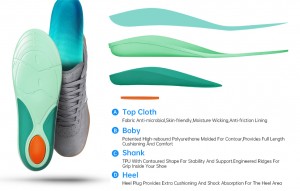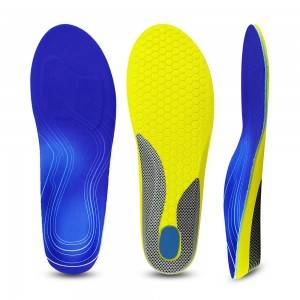Sports Performance Arch Support Fitness Walking Insoles



FAQs
Are insoles good for running?
In a study published in the Journal of the American Podiatric Medical Association, it was demonstrated that cushioned insoles do reduce peak impact force while running. There are many conditions and injuries associated with the repeated impact of running such as heel spurs and plantar fasciitis. Beyond that, if the insoles correct anatomical misalignment, they may reduce the likelihood of musculoskeletal injury.
Do I need custom insoles for running?
If you have pain during running or brisk walking, it is important to consult with your doctor to determine the cause before attempting to relieve that pain by adding running inserts. From there, it is best to identify your reason for using insoles. Some runners add insoles for additional cushion or because the factory insoles of their athletic shoes are uncomfortable. Insoles, along with body alignment exercises, can also help with alignment and arch support. All of these things can typically be accomplished without needing a custom orthotic. Custom insoles can also be cost-prohibitive and stiff, which makes running more difficult for some.
How long do running shoe inserts last?
The lifespan of a running insert depends heavily on the frequency of use. If the inserts are used for a high-intensity running routine such as training for a marathon, they may need to be replaced every three or four months. If the inserts are used for a less intense exercise plan such as a short jog a few times a week, they could last six months or longer. The key is to check to see how much the cushion if the insert has compressed from the heat and pressure of use.
What are the best types of over-the-counter running insoles?
When choosing insoles, it is important to think through what you want to improve in your running experience. Many over-the-counter running insoles just offer cushioning with little arch support or alignment technology. Fit is also a factor as many running shoes have a low volume and not much room to add a thick insole. Beyond that, if you overpronate or supinate, or suffer from a condition such as plantar fasciitis, you will likely also need an insole that can help correct your alignment but is also flexible enough to allow free movement. The T-Series is the best fit for many runners because it offers a moderate degree of arch support along with alignment technology, a flexible, cushioned footbed, and a slim design.
How to choose running insoles
First, check your shoe to see if the factory insole is removable with a gentle tug. If the insole can be easily removed, it is best to look for a full-length insole to replace it. If the insole that came with your shoe is sewn in, you will be looking for a partial-length insole. Next, you want to factor in the amount of arch support and cushioning you need.









